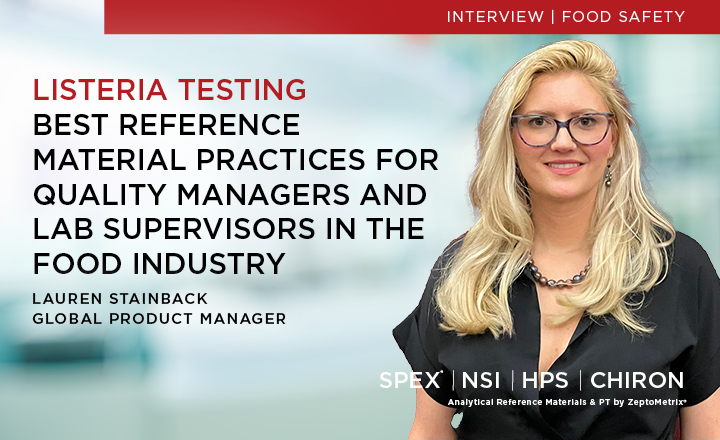Enhance Your Confide...
16th September 2024 Content supplied by: SPEX® + NSI + HPS + CHIRON
The Ultimate Guide: Mastering Listeria Detection With Live Culture Reference Materials
The role of quality managers and lab supervisors in the food industry is crucial in preventing Listeria contamination and in meeting regulatory requirements such as the FDA Food Safety Modernization Act (FSMA) and Hazard Analysis and Risk-based Preventive Controls (HARPC). But how do senior management teams ensure their Listeria testing procedures are the best they can be?
The answer lies in challenging their procedures and test protocols using known certified reference materials (CRM) and by taking part in Proficiency Testing (PT) schemes. These good housekeeping practices not only enhance the accuracy of the tests but also bolster your quality control measures, ultimately safeguarding lives and protecting your brand's reputation.
Incorporating the use of CRMs is highly recommended for a variety of purposes, such as when introducing and validating new microbiological methods, verifying existing protocols, calibrating analytical instruments, and general quality control applications. Additionally, it is crucial to include CRM and PT schemes in staff onboarding and training programmes.
In this interview with Listeria reference culture expert Lauren Stainback, Global Product Manager, NSI, we'll take a dive deep into the world of Listeria reference materials, unveiling industry-leading practices that will revolutionize your approach to food safety. Are you ready to take confidence in your Listeria testing regimen to the next level?
Q: What makes testing for Listeria so difficult?
Lauren: There is no ideal test for differentiating Listeria species. There are culture-based phenotypic tests and molecular-based tests. As Listeria can cause illness even at low infective doses, detection methods need to be highly sensitive to ensure food safety.
Listeria species are closely related genetically, making it difficult to design molecular tests that specifically target L. monocytogenes without cross-reacting with harmless Listeria strains plus the presence of DNA from dead cells can also give false positives, leading to costly incorrect product holds or failures.
Q: Qualitative versus Quantitative CRMs for Listeria, what’s the difference and how does a user choose?
Lauren: Qualitative CRMs have a confirmed live culture present, and that bacteria strain ID is known and traceable back to the primary cell line from which it is derived. Quantitative CRMs take that a step further and have traceable live cultures that are certified to deliver a known CFU level after hydrating, plating, and incubating them.
Qualitative CRMs will help the analyst confirm that the presence of Listeria can be determined. However, you can get false negatives if the method is not sensitive enough and false positives if it is too sensitive. To confirm the method detection limits of the test method, you need quantitative controls or controls that have a known CFU value to challenge the test method’s responsiveness at low and high levels of bacterial concentration.
Food, pharmaceutical, and other consumer product manufacturers often use live cultures to challenge their sterilization and pasteurization processes. If they introduce a known amount of bacteria to their cleaning process, the goal is to examine if any survive. Ideally you want to kill them all, but you need to make sure they were present and plentiful enough to cause an issue in the first place to judge the effectiveness of the “kill step” be it pasteurization, sterilization, or some other decontamination process.
Q: NSI offer qualitative known CFU live cultures of Listeria monocytogenes, L. innocua and L. ivanovii – how does a lab choose which species to use?
Lauren: Honestly labs should be buying at least two strains and L. monocytogenes, (or L. mono), and a non-L. mono listeria species while regularly performing QC with both strains. Labs should be using L. mono as a positive control for confirmatory QC work as well as non L. mono strains to ensure media selectivity is accurate.
Q: Why ‘live’? - Are these better than molecular controls, are there issues of bringing live culture onto a food processing site?
Lauren: AOAC, Standard Methods, FDA BAM, and USDA MLG methods are the most prevalent in North American labs. Food for human consumption is required to be tested via validated cultural methods. Molecular methods are seen as screening tools only. Molecular and Mass Spectrometry are used for genetic testing which is mostly used to determine strain identities.
Your average food manufacturing plant does not care which strain ID of L. monocytogenes they have on their hands. They are focused on eliminating the L. mono pathogen from their processes and site regardless of strain ID. They are concerned with their products being tested accurately and quickly so that they can ship out finished products to buyers.
They use cultural methods for all their product testing as that is what is accepted by their regulators and customers. Some companies are performing molecular techniques for research purposes or to better screen the isolates that pop up inside of their facilities. But most routine testing is being performed via cultural methods. Thus, live bacteria CRMs are crucial for method validation and ongoing QC work with their media.
Q: What format are the SPEX CRMs presented in, are they easy to prepare and what is the shelf life?
Lauren: All of our microbiological CRMs from NSI are live cultures that are freeze-dried into individual pellets. Each pellet is vacuum-sealed into a glass vial. Then those sealed vials are labelled and stored in a typical freezer at -10 to -20°C for 24 months of shelf life.
To use, the lyophilized material is reconstituted with sterile water, then homogenized to thoroughly mix and ensure uniform distribution of the Listeria cells.
The reconstituted sample is typically incubated at room temperature for a short period (usually 30-60 minutes) to allow for complete hydration. If necessary, the sample may be diluted to achieve the desired concentration for testing purposes.
The prepared CRM is then ready to be used as a control or reference in microbiological testing procedures for Listeria detection and quantification.
Q: What advantages over other providers do NSI Standards and Proficiency Testing schemes offer?
Lauren: NSI proficiency tests are finished in a format that allows the test takers to initiate their PT sample prep at any point during the open study period. This gives the analysts scheduling flexibility for all of their PTs.
Other suppliers’ PT samples are typically pre-hydrated, so they are shipping bacterially spiked water and the analyst has to initiate testing upon receipt of those PT samples. Typically, they have less than two days to start their testing. This does not always align with their schedules. When I was a lab director, and we had an influx of stormwater samples to test for paying customers, there were many PT samples that we trashed because we simply could not get to them in time. It was a complete waste of money.
ZeptoMetrix and its brands NSI and SPEX make us a one-stop-shop for all chemistry and microbiological PTs and CRMs. We have the broadest catalog of products available at competitive prices. Our quality and customer service receives great reviews.
Personally, I’ll get on 1:1 virtual meeting to show a new PT or CRM customer how to use our products or navigate some applications or even troubleshooting with them. That is how we learn and that inevitably leads to developing new products. Plus, it shows our scientific commitment to our customers.
Another important distinction is that the PTs are manufactured on-site by the scientific experts at NSI, and the team providing technical support are the same people that oversee the manufacturing of the CRMs and PTs that we sell. Having the manufacturing scientists on hand allows us to quickly help customers when they need our expertise. Critically important when our PT customers are under pressure due to the time constraints of their PT test schedule.
Q: Can CRMs and PT samples be considered close to real-world samples? e.g. those with sub lethally injured cells or high background flora or difficult matrices?
Lauren: Yes, due to how the NSI microbiology products are made, all life stages and cellular injuries are present. That is due to the way the cells are taken in the log growth phase and lyophilized. We also inoculate or contaminate real consumer product matrices and lyophilize the entire material in individually aliquoted units. We sell multi-organism pellets that contain multiple different bacterial species in a single pellet. It simplifies prep when many bacterial tests are being run concurrently. Secondly, it is a great way to have background flora that is well characterized since our multi-organism products are quantitatively certified.
Q: Will both CRMS and PTs highlight problems in testing?
Lauren: PTs and CRMs serve two different functions. Proficiency Tests are an independent third-party evaluation of the results generated by the participant. CRMs are products that should be used routinely to ensure the data being generated by the testing activities of the lab are accurate. CRMs are a tool and study guide. PTs are the final exam. Proficiency testing is required for accreditation under ISO 17025. Most labs perform PT solely for ISO 17025 compliance. However, we are seeing more and more customers, especially globally recognized conglomerates, use PT as a quarterly quality check. They are checking to make sure each of their sites could pass a third-party test. Basically, the army equivalent of training exercises. It is the way to ensure they are producing accurate results. The risk to their brand is immeasurable, so a few hundred dollars per quarter per site is cheap “insurance” that the lab is capable.
When a lab fails to match the Certificate of Analysis (COA) of a CRM or fails to reach the correct finding in a PT, it will need to track back to discover what went wrong— it could be as simple as the incubation temperature not being correct, resulting in poor recovery of Listeria.
Q: What are the advantages of using both a CRM and PT combined?
Lauren: A lab buys a CRM to perform appropriate analysis of it and evaluate their results against the certified values assigned to the CRM. The lab will compare their results to those of the CRM-certified values and assess accuracy by comparison. When the CRM manufacturer and the end user are performing equivalent analytical methods using that same lot of reference material, the results should be comparable. Will the lab’s results match the COA exactly? No but they should be comparable. Within 2-3 standard deviations of the mean value for repeated testing is typical for bacterial CRMs. Each lab has their own measurement uncertainty. That’s important to realize how much your personnel’s techniques, pipettes, balances, and glassware contribute to your overall accuracy and reproducibility. It all adds up! CRMs always state their measurement uncertainty on the COA since it is required under ISO 17034. Hence why using a CRM as the benchmark is important. If you treat the analysis of a CRM as an open book test, and your results are within acceptable limits, then I think you are ready to perform proficiency tests and pass.
Take the first step to revolutionize your approach to Listeria detection - Visit NSI Lab Solutions or use the request information button below
About Lauren Stainback:

Tags:
Date Published: 16th September 2024
Source article link: View
Related news
Enhance Your Confidence With Industry-leading



